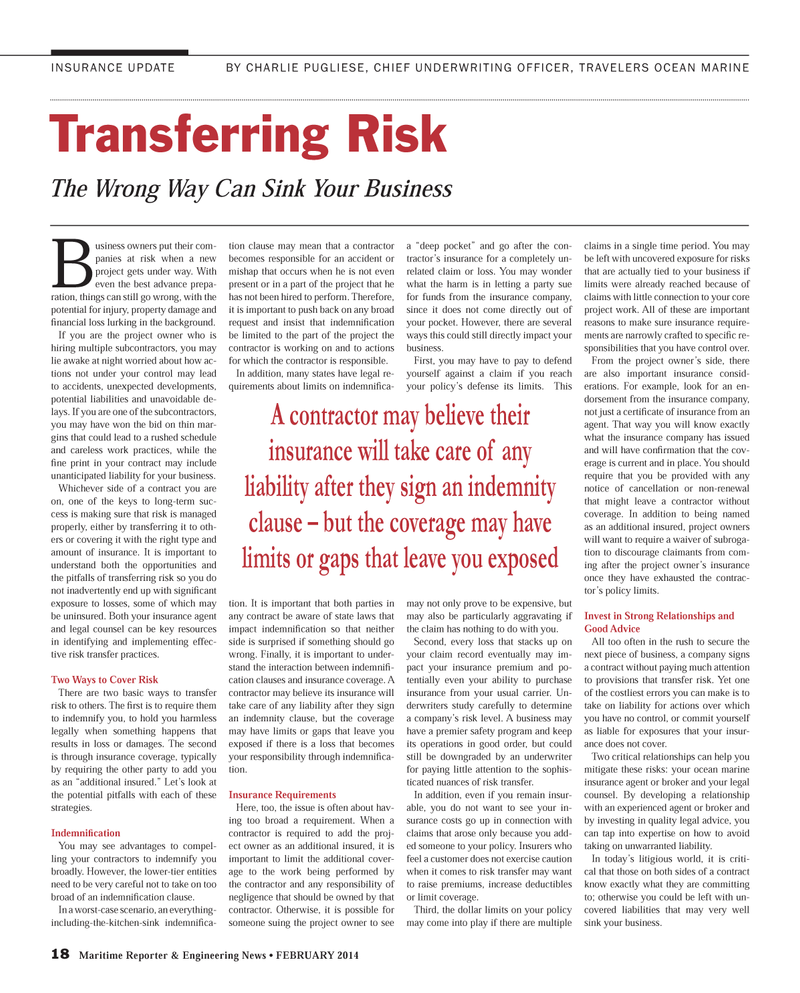
Page 18: of Maritime Reporter Magazine (February 2014)
Cruise Shipping Edition
Read this page in Pdf, Flash or Html5 edition of February 2014 Maritime Reporter Magazine
18 Maritime Reporter & Engineering News • FEBRUARY 2014
INSURANCE UPDATE
B usiness owners put their com- panies at risk when a new project gets under way. With even the best advance prepa- ration, things can still go wrong, with the potential for injury, property damage and fi nancial loss lurking in the background.
If you are the project owner who is hiring multiple subcontractors, you may lie awake at night worried about how ac- tions not under your control may lead to accidents, unexpected developments, potential liabilities and unavoidable de- lays. If you are one of the subcontractors, you may have won the bid on thin mar- gins that could lead to a rushed schedule and careless work practices, while the fi ne print in your contract may include unanticipated liability for your business.
Whichever side of a contract you are on, one of the keys to long-term suc- cess is making sure that risk is managed properly, either by transferring it to oth- ers or covering it with the right type and amount of insurance. It is important to understand both the opportunities and the pitfalls of transferring risk so you do not inadvertently end up with signifi cant exposure to losses, some of which may be uninsured. Both your insurance agent and legal counsel can be key resources in identifying and implementing effec- tive risk transfer practices.
Two Ways to Cover Risk
There are two basic ways to transfer risk to others. The fi rst is to require them to indemnify you, to hold you harmless legally when something happens that results in loss or damages. The second is through insurance coverage, typically by requiring the other party to add you as an “additional insured.” Let’s look at the potential pitfalls with each of these strategies.
Indemnifi cation
You may see advantages to compel- ling your contractors to indemnify you broadly. However, the lower-tier entities need to be very careful not to take on too broad of an indemnifi cation clause.
In a worst-case scenario, an everything- including-the-kitchen-sink indemnifi ca- tion clause may mean that a contractor becomes responsible for an accident or mishap that occurs when he is not even present or in a part of the project that he has not been hired to perform. Therefore, it is important to push back on any broad request and insist that indemnifi cation be limited to the part of the project the contractor is working on and to actions for which the contractor is responsible.
In addition, many states have legal re- quirements about limits on indemnifi ca- tion. It is important that both parties in any contract be aware of state laws that impact indemnifi cation so that neither side is surprised if something should go wrong. Finally, it is important to under- stand the interaction between indemnifi - cation clauses and insurance coverage. A contractor may believe its insurance will take care of any liability after they sign an indemnity clause, but the coverage may have limits or gaps that leave you exposed if there is a loss that becomes your responsibility through indemnifi ca- tion.
Insurance Requirements
Here, too, the issue is often about hav- ing too broad a requirement. When a contractor is required to add the proj- ect owner as an additional insured, it is important to limit the additional cover- age to the work being performed by the contractor and any responsibility of negligence that should be owned by that contractor. Otherwise, it is possible for someone suing the project owner to see a “deep pocket” and go after the con- tractor’s insurance for a completely un- related claim or loss. You may wonder what the harm is in letting a party sue for funds from the insurance company, since it does not come directly out of your pocket. However, there are several ways this could still directly impact your business.
First, you may have to pay to defend yourself against a claim if you reach your policy’s defense its limits. This may not only prove to be expensive, but may also be particularly aggravating if the claim has nothing to do with you.
Second, every loss that stacks up on your claim record eventually may im- pact your insurance premium and po- tentially even your ability to purchase insurance from your usual carrier. Un- derwriters study carefully to determine a company’s risk level. A business may have a premier safety program and keep its operations in good order, but could still be downgraded by an underwriter for paying little attention to the sophis- ticated nuances of risk transfer.
In addition, even if you remain insur- able, you do not want to see your in- surance costs go up in connection with claims that arose only because you add- ed someone to your policy. Insurers who feel a customer does not exercise caution when it comes to risk transfer may want to raise premiums, increase deductibles or limit coverage.
Third, the dollar limits on your policy may come into play if there are multiple claims in a single time period. You may be left with uncovered exposure for risks that are actually tied to your business if limits were already reached because of claims with little connection to your core project work. All of these are important reasons to make sure insurance require- ments are narrowly crafted to specifi c re- sponsibilities that you have control over.
From the project owner’s side, there are also important insurance consid- erations. For example, look for an en- dorsement from the insurance company, not just a certifi cate of insurance from an agent. That way you will know exactly what the insurance company has issued and will have confi rmation that the cov- erage is current and in place. You should require that you be provided with any notice of cancellation or non-renewal that might leave a contractor without coverage. In addition to being named as an additional insured, project owners will want to require a waiver of subroga- tion to discourage claimants from com- ing after the project owner’s insurance once they have exhausted the contrac- tor’s policy limits.
Invest in Strong Relationships and
Good Advice
All too often in the rush to secure the next piece of business, a company signs a contract without paying much attention to provisions that transfer risk. Yet one of the costliest errors you can make is to take on liability for actions over which you have no control, or commit yourself as liable for exposures that your insur- ance does not cover.
Two critical relationships can help you mitigate these risks: your ocean marine insurance agent or broker and your legal counsel. By developing a relationship with an experienced agent or broker and by investing in quality legal advice, you can tap into expertise on how to avoid taking on unwarranted liability.
In today’s litigious world, it is criti- cal that those on both sides of a contract know exactly what they are committing to; otherwise you could be left with un- covered liabilities that may very well sink your business.
Transferring Risk
The Wrong Way Can Sink Your Business
BY CHARLIE PUGLIESE, CHIEF UNDERWRITING OFFICER, TRAVELERS OCEAN MARINE
A contractor may believe their insurance will take care of any liability after they sign an indemnity clause – but the coverage may have limits or gaps that leave you exposed
MR #2 (18-25).indd 18 2/5/2014 10:08:07 AM

 17
17

 19
19
